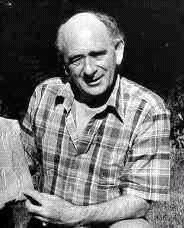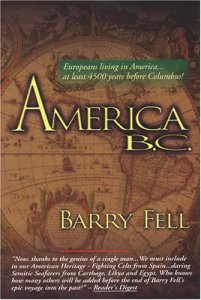Prima di Cristoforo Colombo, in Nord America, c'erano i Clovis. Prima ancora i Pre-Clovis. Come giunsero e da dove è dibattuto. Ma un Inglese - Barry Fell, appunto - che si era laureato con una tesi sulle ofiuroidee, divenuto un'autorità mondiale sugli echinodermi, decise nel 1973 di "cambiare vita" e si rivolse all'epigrafia (ti ricorda qualche cosa questo, Pasuco?). Fondò la "Epigraphic Society" e scrisse un libro (eh, quanti obblighi si devono soddisfare!). Dichiarò presto di avere trovato sparse in giro per il territorio degli Stati Uniti numerose iscrizioni in varie lingue del Vecchio Mondo (neanche questo ti fa venire in mente qualche cosa, amico mio?), provenienti da viaggiatori transatlantici di Egitto, Irlanda, Iberia e Cartagine. Rintracciò numerose tracce della presenza Vichinga ed infine rinvenne (in Canada, Peterborough, Ontario) scritti Scandinàvi di duemila anni più antichi delle più antiche rune trovate in Europa. Le sue impressionanti abilità di epigrafista autodidatta gli hanno permesso di spaziare tra la traduzione del Disco di Festo alla traduzione delle tavole Rongo-Rongo di Rapa Nui. Mi fermo qui: accludo l'articolo originale per chi volesse leggerlo. Aggiungo solamente che il mondo scientifico dei linguisti ufficiali non gli ha dato alcun credito: ma, si sa, la Scienza Ufficiale non comprende la Fantasia Creativa.
Old World people in the New World before Columbus?

Cristoforo Colombo (1451-1506); not the discoverer of America or even the first European discoverer of America
In posing the question, I’m not asking about Native Americans: although their origins in East Asian Upper Palaeolithic populations is not in doubt (even if the date of their arrival in the Americas remains hugely controversial), it is claims that people from Europe crossed the Atlantic Ocean before 1492 that I want to examine. It’s a huge area, with claims ranging from Magdalenian hunter-gatherers to late medieval fishermen from Bristol (England), and supported by a variety of evidence, from artefacts to inscriptions. Claims have been made both by professional archaeologists and by amateur enthusiasts, often with a murky overlap in white supremacist subcultures.
In this post, I won’t be looking in detail at the claims made by academic archaeologists, for whom the first peopling of the Americas is still very much open to serious debate. The long held orthodox view, that the users of Clovis Points were the earliest humans in the New World, is coming increasingly under fire as new sites are discovered that appear to pre-date the earliest sites with Clovis Point technology. Even the origins of the points arouses controversy, with some suggesting a West European origin for the technique of production; there are certainly no a priori reasons why small numbers of Late Upper Palaeolithic Europeans could not have crossed the Atlantic, hugging the ice sheets that extended much farther south than today and subsisting on fish, seal and whale meat. However, ideas like this are currently just speculation: evidence to back them up is required before they will become accepted.
Barry Fell
The one name that you are perhaps more likely to come across than any other as a proponent of pre-Columbian contact with the Old World is Howard Barraclough (Barry) Fell (1917-1994). Born in England, he emigrated with his mother to New Zealand in the 1920s, but returned to the UK to gain a PhD from the University of Edinburgh in 1941; his thesis was titledDirect Development in the Ophiuroidea and its Causes (Ophiuroidea are the class of brittle stars). By then, he had already developed an interest in petroglyphs, publishing ‘The pictographic art of the ancient Maori of New Zealand’ (Man 61, 85-8) in 1941. After a spell in the British army, he returned to New Zealand in 1946, where he took up a post as Senior Lecturer in Zoology at the Victoria University College in Wellington, being promoted to Associate Professor in 1957. He became a world authority on echinoderms and in 1964, he was offered and accepted a post as Curator in Invertebrate Zoology at the Museum of Comparative Zoology at the University of Harvard. Later, he became Professor of Invertebrate Zoology.
In 1973, he made a life changing decision to abandon his echinoderm research and turn to the study of epigraphy, founding the Epigraphic Society in July 1974 with his wife Rene and their friend Peter Garfall. Barry Fell was elected as the Society’s first president with the historian Norman Totten of Bentley College (now Bentley University) in Boston as vice president (he is now the Society’s president). His book America BC: Ancient Settlers in the New World, first published in 1978, brought him to wide attention and he soon developed a following of devoted supporters. He claimed to recognise a variety of Old World scripts in rock-cut inscriptions across the USA, supposedly created by transatlantic voyagers from Egypt, the Iberian Peninsula, Ireland, Carthage and elsewhere. This was followed in 1980 bySaga America, an exposition of supposedly Viking era remains, and in 1982 by Bronze Age America, concentrated on recognising ‘Bronze Age’ Scandinavian texts, two thousand years older than any known runic inscriptions in Europe, at Peterborough, Ontario (Canada). His supposed abilities ran to a translation of the unique Phaistos Disc and the Rongorongo boards of Rapa Nui (Easter Island), neither of which has won acceptance among linguists.
One of the claims made by his supporters is that mainstream academics reject his findings because he was an amateur and lacked the long experience necessary to master the variety of scripts he claimed to be able to decipher. This is true to the extent that there are few, if any, linguists competent in as many ancient languages and scripts as Fell claimed to be, even though there is no denying that he was multilingual. His amateur status, though, is a red herring: Michael Ventris, one of the co-decipherers of Linear B, was an amateur and professionals listened to him because his arguments were based on solid evidence and were convincing. Fell’s arguments are not. His analysis of supposedly Celtic elements in Native American placenames and languages is fanciful; his identification of scratches on rock surfaces as Irish Ogham script shows his lack of familiarity with real Ogham. It is possible to go on, but the point is that Fell’s belief in his own linguistic abilities was not matched by genuine linguists’ faith in him; indeed, Fell worked in a scholarly vacuum, not engaging with genuine experts, publishing in his own society’s journals and monographs not subject to peer review by professional linguists. Rejection of his ideas is not because other scholars are closed-minded and unwilling to accept such ideas but because the evidence on which he based his radical hypotheses about widespread contact between the Old and New Worlds long before Columbus does not stand up to even the slightest critical scrutiny.

